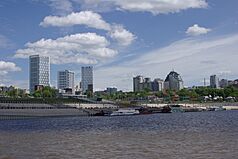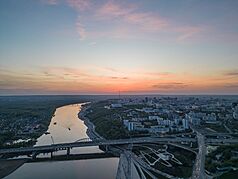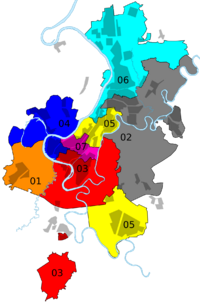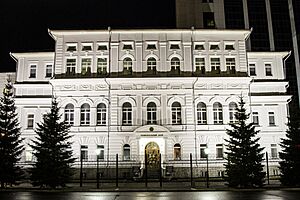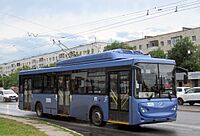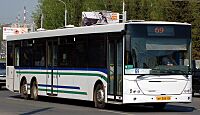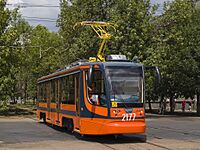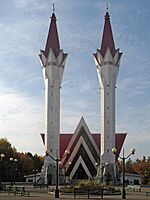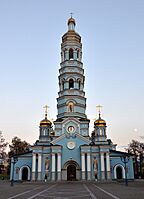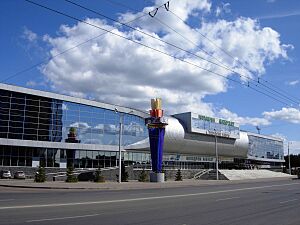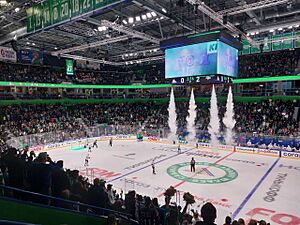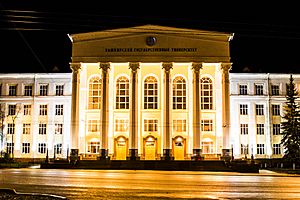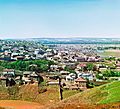Ufa facts for kids
Quick facts for kids Ufa (English)Уфа (Russian) Өфө (Bashkir) |
|
|---|---|
| - City - | |
| [[File:
From the top to bottom-right, Aerial view of Central Ufa, Lala Tulpan, Monument to Salavat Yulaev, New Belsky Bridge, Ufa Cathedral
|
|
|
|
|
| Anthem | none |
| Administrative status | |
| Country | Russia |
| Federal subject | Republic of Bashkortostan |
| Administratively subordinated to | city of republic significance of Ufa |
| Capital of | Republic of Bashkortostan |
| Municipal status | |
| Urban okrug | Ufa Urban Okrug |
| Head | Ratmir Mavliev |
| Representative body | City Council |
| Statistics | |
| Area | 707.93 km2 (273.33 sq mi) |
| Population (2010 Census, preliminary) |
1,062,319 inhabitants |
| - Rank in 2010 | 11th |
| Population (January 2016 est.) | 1,121,429 inhabitants |
| Density | 1,501/km2 (3,888/sq mi) |
| Time zone | YEKT (UTC+06:00) |
| Founded | 1574 |
| City status since | 1586 |
| Postal code(s) | 450000–450010, 450013–450015, 450017–450019, 450022, 450024, 450026–450030, 450032–450035, 450037–450040, 450043–450045, 450047, 450049–450059, 450061–450065, 450068, 450069, 450071, 450073–450081, 450083, 450091–450093, 450095–450101, 450103–450106, 450880, 450890, 450911–450948, 450951–450966, 450971–450979, 450981–450986, 450989–450999, 901139, 901229, 992200 |
| Dialing code(s) | +7 347 |
| Official website: http://ufacity.info | |
Ufa is a large and important city in Russia. It is the capital of Bashkortostan, a republic within Russia. Ufa is located where the Belaya and Ufa rivers meet. This area is on hills west of the southern Ural Mountains.
Ufa is home to over 1.1 million people. This makes it the tenth-largest city in Russia. It is also the fourth-largest city in the Volga Federal District.
The city was started in 1574. A fortress was built here by order of Ivan the Terrible. Ufa became a capital city in 1865. Its population grew a lot in the early 1900s.
Today, Ufa is known for its industries. These include oil refining, chemistry, and mechanical engineering. The big oil company Bashneft has its main offices here. Ufa is a city with many different ethnic groups. It has many Bashkirs and Tatars, but most people are Russian. Ufa also has many universities. In 2015, Ufa hosted important meetings for the BRICS group and the Shanghai Cooperation Organisation.
Contents
What's in a Name?
The name Ufa comes from the Ufa River. The exact meaning of the river's name is not fully known. Some experts think it comes from an old Iranian word "ap," which means "water."
Other researchers believe there was an old settlement called Ufa here before the fortress was built in 1574. They think ancient Turkic tribes founded this place. It might have been a special spot for rituals. They called such places "opo" or "ope." The people living there might have been called the Upe or Ufe tribe. Then, the river got its name from them. The Russian fortress builders likely knew this old name. That is why they named their new settlement Ufa.
A Look Back in Time
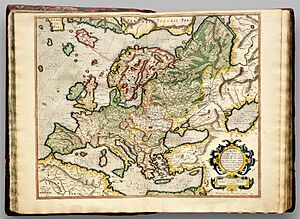
People have lived in the Ufa area since ancient times. There might have been a medieval city here from the 5th to 16th centuries. Old maps from the 1300s show a town called Pascherti (Bashkort) near the Belaya River. Some historians think this was Ufa.
An Arab historian named Ibn Khaldun called a town in this area Bashkort. He said it was one of the largest cities of the Golden Horde. Another Russian historian, Peter Rychkov, wrote that a big city existed here before the Russians arrived.
In 1574, Ivan the Terrible ordered a fortress to be built. This fortress was on a hill called Tura-Tau. This year, 1574, is now the official founding date of Ufa. The settlement became a town in 1586.
Ufa became the center of its own region in 1781. This region was called Ufa Governorate. Later, in 1802, Ufa became the main city for the larger Orenburg Governorate. This area included parts of today's Republic of Bashkortostan, Orenburg Oblast, and Chelyabinsk Oblast.
New waterways and railroads helped Ufa grow. The Belaya River Waterway opened in 1870. The Samara-Zlatoust Railroad arrived in 1890. These connections helped the city's industries develop. During World War II, many factories from western Russia were moved to Ufa for safety.
In July 2015, Ufa hosted important international meetings. These included summits for the BRICS group and the Shanghai Cooperation Organisation.
City Layout
Ufa is the capital of Bashkortostan. It also serves as the main city for Ufimsky District. However, Ufa itself is not part of that district. It is a special city with its own administration.
Ufa is divided into seven main areas called administrative districts. Each district has its own population.
| No. | District | Population as of January 1, 2020 |
|---|---|---|
| 1 | Dyomsky | 80,714 |
| 2 | Kalininsky | 207,750 |
| 3 | Kirovsky | 162,958 |
| 4 | Leninsky | 89,062 |
| 5 | Oktyabrsky | 246,476 |
| 6 | Ordzhonikidzevsky | 164,682 |
| 7 | Sovetsky | 177,145 |
Economy and Business
In 2013, Forbes magazine said Ufa was the best city in Russia for business. This was for cities with over one million people.
Ufa's economy is mainly based on industry. Many factories here work with oil refining, chemicals, and making machines. The city also has many businesses related to fuel and energy.
There are about 200 large and medium-sized factories in Ufa. Some important companies include:
- Ufa Engine-Building Production Association: This company makes gas turbine engines.
- Ufimsky petrochemical Plant: This is a large chemical factory.
- Novo-Ufimsky refinery plant: This plant refines oil.
- Ufimsky refinery plant: Another oil refining plant.
- Bashkir Trolleybus Manufacturing Plant JSC: This company makes trolleybuses.
Getting Around Ufa
Ufa is well-connected to other parts of Russia. The Ufa Station is on a historic branch of the Trans-Siberian Railway. Ufa is also unique because it has more than one federal highway connecting it to Moscow. The M7 motorway goes to Kazan and Moscow. The M5 motorway links Ufa to Moscow and to the Asian part of Russia.
The Ufa International Airport has flights to other countries like Turkey and Egypt. It also has many flights to cities within Russia, including Moscow.
Ufa has public transportation like trams (since 1937) and trolleybuses (since 1962). There are also bus lines and marshrutka (shared taxis). A subway system for Ufa has been planned for a long time.
People of Ufa
| Historical population | ||
|---|---|---|
| Year | Pop. | ±% |
| 1897 | 49,275 | — |
| 1926 | 97,737 | +98.4% |
| 1939 | 250,011 | +155.8% |
| 1959 | 546,878 | +118.7% |
| 1970 | 770,905 | +41.0% |
| 1979 | 969,289 | +25.7% |
| 1989 | 1,082,052 | +11.6% |
| 2002 | 1,042,437 | −3.7% |
| 2010 | 1,062,319 | +1.9% |
| 2021 | 1,144,809 | +7.8% |
| Source: Census data | ||
Ufa's population grew past one million people in 1980. It is the 10th most populated city in Russia. It is also the 26th most populated city in Europe.
Here is a look at the different ethnic groups in Ufa, based on the 2021 Census:
| Ethnicity | Number | Percentage |
|---|---|---|
| Russians | 557,492 | 48.9% |
| Tatars | 308,381 | 27.0% |
| Bashkirs | 233,128 | 20.4% |
| Others | 41,618 | 3.6% |
Beliefs and Religions
Religion in Ufa (2024) Islam (52.5%) Orthodox (32.5%) Other Christian (3%) Other (2%) non-religious individuals (10%)
The main religions in Ufa are Sunni Islam and Russian Orthodoxy. There are also some Old Believers here.
Ufa is home to the Central Spiritual Administration of Muslims in Russia. The Russian Islamic University opened in 1989. One of Europe's largest mosques, Ar-Rahim, is being built in Ufa.
Where is Ufa?
Ufa is in Eastern Europe, close to the border with Northern Asia. It sits where the Belaya and Ufa Rivers meet. The city is on low hills that form the Ufa Plateau. This area is west of the southern Urals.
The city covers an area of about 707.93 square kilometers (273.33 sq mi). It stretches for 53.5 kilometers (33.2 mi) from north to south. From west to east, it is 29.8 kilometers (18.5 mi) wide.
Ufa's Weather
Ufa has a warm summer continental climate. This means it has cold winters. However, summers can sometimes be long and hot. The coldest temperature ever recorded in Ufa was −48.5 °C (−55.3 °F) on January 1, 1979. The hottest temperature was 39.4 °C (102.9 °F) on July 10, 2023.
| Climate data for Ufa (1991–2020, extremes 1853–present) | |||||||||||||
|---|---|---|---|---|---|---|---|---|---|---|---|---|---|
| Month | Jan | Feb | Mar | Apr | May | Jun | Jul | Aug | Sep | Oct | Nov | Dec | Year |
| Record high °C (°F) | 5.8 (42.4) |
9.2 (48.6) |
16.2 (61.2) |
31.1 (88.0) |
36.2 (97.2) |
38.3 (100.9) |
39.4 (102.9) |
38.5 (101.3) |
33.4 (92.1) |
26.8 (80.2) |
15.4 (59.7) |
5.0 (41.0) |
39.4 (102.9) |
| Mean daily maximum °C (°F) | −8.1 (17.4) |
−6.6 (20.1) |
0.6 (33.1) |
11.4 (52.5) |
20.5 (68.9) |
24.3 (75.7) |
26.0 (78.8) |
24.0 (75.2) |
17.6 (63.7) |
9.1 (48.4) |
−0.5 (31.1) |
−6.8 (19.8) |
9.3 (48.7) |
| Daily mean °C (°F) | −12.2 (10.0) |
−11.6 (11.1) |
−4.4 (24.1) |
5.7 (42.3) |
13.7 (56.7) |
17.9 (64.2) |
19.8 (67.6) |
17.6 (63.7) |
11.6 (52.9) |
4.9 (40.8) |
−3.5 (25.7) |
−10.4 (13.3) |
4.1 (39.4) |
| Mean daily minimum °C (°F) | −16.8 (1.8) |
−16.7 (1.9) |
−9.5 (14.9) |
0.2 (32.4) |
7.0 (44.6) |
11.4 (52.5) |
13.5 (56.3) |
11.8 (53.2) |
6.6 (43.9) |
1.3 (34.3) |
−6.6 (20.1) |
−14.5 (5.9) |
−1.0 (30.2) |
| Record low °C (°F) | −48.5 (−55.3) |
−43.5 (−46.3) |
−34.4 (−29.9) |
−27.8 (−18.0) |
−9.7 (14.5) |
−1.2 (29.8) |
1.4 (34.5) |
−0.1 (31.8) |
−6.8 (19.8) |
−25.6 (−14.1) |
−35.1 (−31.2) |
−45.0 (−49.0) |
−48.5 (−55.3) |
| Average precipitation mm (inches) | 46 (1.8) |
39 (1.5) |
38 (1.5) |
31 (1.2) |
51 (2.0) |
63 (2.5) |
51 (2.0) |
55 (2.2) |
48 (1.9) |
57 (2.2) |
47 (1.9) |
51 (2.0) |
577 (22.7) |
| Average extreme snow depth cm (inches) | 31 (12) |
42 (17) |
40 (16) |
6 (2.4) |
0 (0) |
0 (0) |
0 (0) |
0 (0) |
0 (0) |
0 (0) |
5 (2.0) |
17 (6.7) |
42 (17) |
| Average rainy days | 3 | 3 | 6 | 12 | 16 | 16 | 15 | 16 | 18 | 18 | 11 | 4 | 138 |
| Average snowy days | 25 | 21 | 16 | 6 | 1 | 0 | 0 | 0 | 1 | 8 | 20 | 24 | 122 |
| Average relative humidity (%) | 83 | 80 | 77 | 69 | 61 | 68 | 71 | 74 | 76 | 79 | 83 | 83 | 75 |
| Mean monthly sunshine hours | 54.4 | 96.1 | 159.0 | 219.9 | 278.9 | 300.6 | 314.4 | 250.7 | 160.2 | 88.1 | 54.5 | 42.8 | 2,019.6 |
| Source 1: Pogoda.ru.net | |||||||||||||
| Source 2: NOAA | |||||||||||||
Sports in Ufa
Ufa is home to many sports teams and venues.
| Club | Sport | Founded | League | League Rank |
Stadium |
|---|---|---|---|---|---|
| Salavat Yulaev Ufa | Ice Hockey | 1961 | Kontinental Hockey League | 1st | Ufa Arena |
| Tolpar Ufa | Ice Hockey | 2009 | Minor Hockey League | Jr. 1st | Ice Palace Salavat Yulaev |
| HC Agidel Ufa | Ice Hockey | 2010 | Russian Women's Hockey League | 1st | Ice Palace Salavat Yulaev |
| FC Ufa | Football | 2009 | Russian First League | 1st | Neftyanik Stadium |
| Ural Ufa | Volleyball | 1992 | Volleyball Super League | 1st | Dynamo Sports Palace |
| Samrau-UGNTU | Volleyball | 1970 | Women's Volleyball Super League | 2nd | Dynamo Sports Palace |
| Ugntu-VNZM | Handball | 1960 | Russian Handball Super League | 1st | Sports Complex UGNTU |
| Ufa-Alisa | Handball | 1989 | Russian Women's Handball Super League | 1st | FOK Sports School 32 |
| Ufimets | Basketball | 2012 | 3rd | BGAU |
The Stroitel Stadium is in the northern part of the city. It is mainly used for Ice speedway races.
A famous speedway club, Bashkiria Ufa, used to be very successful. They won the Soviet Union Championship eleven times. This was between 1962 and 1988. The club stopped in 1998. They raced at the Trud Stadium (Ufa), which was later taken down to build the Ufa Arena.
Learning and Science
Ufa has many important universities and scientific centers. These include:
- Bashkir State University
- Ufa State Aviation Technical University
- Ufa State Petroleum Technological University
- Bashkir State Medical University
- Bashkir State Agrarian University
There are also places for advanced studies and law:
- Ural State Law Academy Ufa's campus
For science, Ufa has:
- Academy of Sciences of the Republic of Bashkortostan
- Ufa Scientific Center of the Russian Academy of Science (USC RAS)
International Connections
Ufa is connected with other cities around the world. These are called "twin towns" or "sister cities." They often share cultural and economic ties.
Images for kids
-
Early color photograph of Ufa taken in 1910 by Sergey Prokudin-Gorsky.
See also
 In Spanish: Ufá para niños
In Spanish: Ufá para niños


